Széchenyi lánchíd - Chain bridge crossing Danube
- Written by Portal Editor
During the exploration of the Budavari Siklo cable railway at the castle mountain of Budapest we had noticed the mighty pillars of the bridge construction, which leads over the Danube. Similar to the Tower Bridge in London, the architecture of the pillar system suggested a construction period before the 20th century.
After the first research, the chain bridge was built between 1839 and 1849 at the instigation of the Hungarian reformer Count István Széchenyi, whose name it still bears today. It is the oldest and most famous of the nine Budapest bridges across the Danube.
Roman Danube bridges
 One of the oldest archaeologically secured bridges is the prehistoric wooden bridge Rapperswil-Hurden, which was built around 1525 BC, connecting the Neolithic settlements of Rapperswil-Jona-Technikum and Freienbach-Hurden-Rosshorn, which was used for several centuries. The constructors mainly used wood as a main building material, but also stone was used to strengthen the wooden pillar. Other prehistoric bridges were known from England and Northern Germany.
One of the oldest archaeologically secured bridges is the prehistoric wooden bridge Rapperswil-Hurden, which was built around 1525 BC, connecting the Neolithic settlements of Rapperswil-Jona-Technikum and Freienbach-Hurden-Rosshorn, which was used for several centuries. The constructors mainly used wood as a main building material, but also stone was used to strengthen the wooden pillar. Other prehistoric bridges were known from England and Northern Germany.
In the 6th century BC, the Babylonians under Nebuchadnezzar II built bridges made of cypress and cedar wood. The construction of arched bridges made of natural stone or concrete was introduced by the Romans for the first time, the Alcántara Bridge still demonstrates this today impressively.
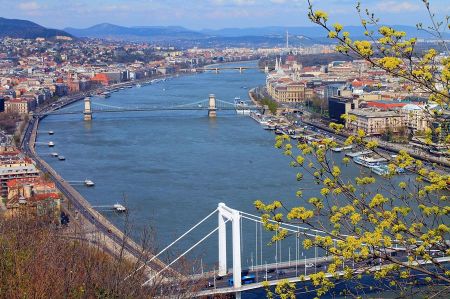 There were various attempts along the Danube, the mighty border- and limes river, to build strong bridges crossing over the river, as in Belgrade, where natural shoals were used to cross the river. Again and again these structures were destroyed due to the strong ice in the winter. Since the 16th / 17th century, a pontoon bridge was built for the crossing of the Danube near Budapest. From the year 1776 it was built up of 46 floating bodies in the spring, linking the two independent cities Buda and Pest.
There were various attempts along the Danube, the mighty border- and limes river, to build strong bridges crossing over the river, as in Belgrade, where natural shoals were used to cross the river. Again and again these structures were destroyed due to the strong ice in the winter. Since the 16th / 17th century, a pontoon bridge was built for the crossing of the Danube near Budapest. From the year 1776 it was built up of 46 floating bodies in the spring, linking the two independent cities Buda and Pest.
However, it had to be dismantled before winter and could only be rebuilt in the spring, because otherwise the ice masses of the free-flowing Danube could have destroyed the pontoon bridge. For this reason, there was no permanent link between the two cities during the winter months, which severely restricted the free movement of people and goods and partly brought them to a standstill. A crossing of the Danube was only possible in the winter when the ice covering was closed, which not only limited the times, but also the transport weights.
István Széchenyi initiated the Budapest Bridges Association
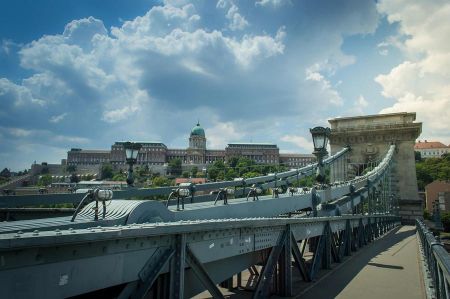 In 1832, István Széchenyi then initiated the foundation of the Budapest Bridge Association, which had the task of bringing together all known bridge designs. In addition, the association should create a new draft, taking into account existing geological surveys of the area. The construction of a bridge between the two cities of Buda and Pest should also promote the exchange of goods in Hungary and modernize business routes. That is why the bridge in Széchenyi's transport concept also played a key role.
In 1832, István Széchenyi then initiated the foundation of the Budapest Bridge Association, which had the task of bringing together all known bridge designs. In addition, the association should create a new draft, taking into account existing geological surveys of the area. The construction of a bridge between the two cities of Buda and Pest should also promote the exchange of goods in Hungary and modernize business routes. That is why the bridge in Széchenyi's transport concept also played a key role.
The design of the chain bridge was commissioned by renowned English engineer William Tierney Clark. The construction management was given to an engineer whose name was Adam Clark, who settled in Hungary after completion of the construction work. His name was dedicated to the square between the chain bridge and the tunnel through the castle mountain. Széchenyi, however, was not only the initiator, but also the organization of the building. In the early 1840s he was the president of the Budapest Transport Council, building materials from a wide variety of countries, as it was impossible to obtain the necessary 2000 tons of steel for the bridge in Budapest.
First construction work in July 1840
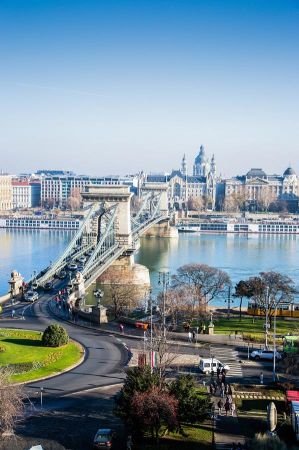 The neoclassical structure is supported by two triumphal arch support pillars, through which the iron chains of the 375 meter long bridge body run, hence the name chain bridge. The arched doors have a passage width of 6.50 meters and the weight of the iron construction is 2,000 tons.
The neoclassical structure is supported by two triumphal arch support pillars, through which the iron chains of the 375 meter long bridge body run, hence the name chain bridge. The arched doors have a passage width of 6.50 meters and the weight of the iron construction is 2,000 tons.
Preparations for the first pillar began on July 28, 1840, when wood piles were driven into the shores as a fencing of the construction site. After these works, which took two years, on the 24th of August, 1842, a solemn foundation was laid in the excavation pit of the Pester abattoir. On November 20, 1849, after a long period of interruption, the construction and completion of the bridge took place.
Between the two pylons a span of 202 meters is bridged. For the next 30 years it was the widest bridge of this type of construction. Széchenyi was never allowed to pass his bridge, since after a collapse in September 1848 he spent the rest of his life in the recreation center of Döblingen in Vienna.
In 1915, the original structure was replaced by a stronger one because it was no longer capable to transport. The wooden parts were replaced by iron and steel. This second bridge consisted of more than 5,000 tons of steel, but the two bridge piers remained unchanged. Material was reused wherever possible. A lot could be produced in Hungary, but the new chain heads on the pylons came from London.
A legend about Count István Széchenyi tells that it would have taken a week before he could cross the Danube to the funeral of his father. So he decided to plan the bridge.
Széchenyi Chain Bridge – The Chain Bridge over the Danube in Budapest - more details
Introduction – A landmark between two parts of the city
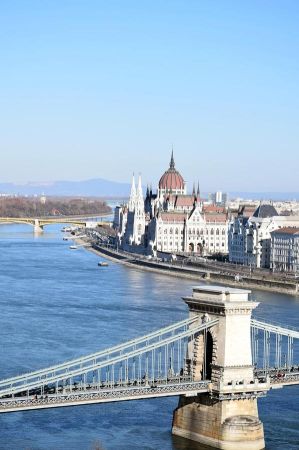 The Széchenyi Chain Bridge, or Széchenyi Lánchíd in Hungarian, is not just a bridge. It is a monument, a symbol, and a historical masterpiece that connects the districts of Buda and Pest across the Danube. When visiting Budapest, there is no way around it.
The Széchenyi Chain Bridge, or Széchenyi Lánchíd in Hungarian, is not just a bridge. It is a monument, a symbol, and a historical masterpiece that connects the districts of Buda and Pest across the Danube. When visiting Budapest, there is no way around it.
Why the Chain Bridge is more than just a bridge
It not only connects two parts of the city geographically, but also two mentalities, two cultures – and the past with the present.
A symbol of progress, connection, and history
As the first permanent bridge over the Danube in Hungary, it was a technical marvel of its time – today it is an emotional link in the heart of the city.
Budapest – One city, two sides
Buda and Pest – The history of one unit
Buda and Pest were once independent cities. It wasn't until 1873 that they were officially united to form the capital city of Budapest – the Chain Bridge played a central role in this.
The Danube as a Dividing Line and Bridge Builder
The Danube is magnificent, but it once divided. Today, through bridges like the Lánchíd, it becomes a symbol of connection.
The Széchenyi Lánchíd at a Glance
Where it is located and what it connects
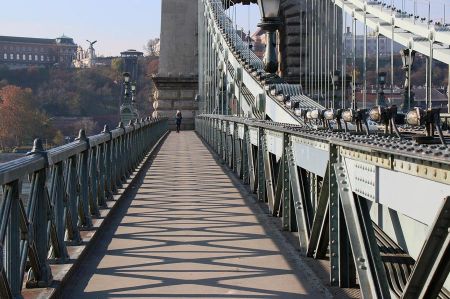 It connects the Castle District in Buda with the inner city of Pest – crossing it on foot offers one of the best views of Budapest.
It connects the Castle District in Buda with the inner city of Pest – crossing it on foot offers one of the best views of Budapest.
Technical Facts in Brief
- Opened: 1849
• Length: approx. 375 meters
• Construction: Iron suspension bridge
• Architect: William Tierney Clark
The Creation of the Chain Bridge
The Dream of István Széchenyi
It was the Hungarian reformer Széchenyi who pushed for the construction of the bridge – for a very personal reason: He was once unable to attend his father's funeral due to flooding.
Construction under the direction of William Tierney Clark
A British engineer planned the project – a masterpiece of Victorian engineering that has survived to this day.
Architecture and Design of the Bridge
The iron structure as a masterpiece of the 19th century
Sturdy, elegant, functional – the bridge is a prime example of early engineering and yet appears almost poetically light.
The famous lion statues – pure symbolism
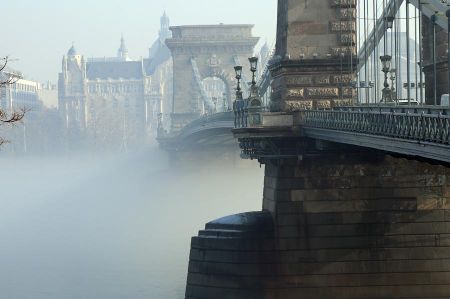 The stone lions at the bridgeheads are legendary. Supposedly tongueless – a myth that has long been disproven.
The stone lions at the bridgeheads are legendary. Supposedly tongueless – a myth that has long been disproven.
Significance for Hungarian History
Symbol of the Unification of Budapest
The bridge was a milestone on the path to becoming a modern capital. Without it, the unification of Buda and Pest would have been unthinkable.
The Bridge as a Place of National Identity
It stands for independence, progress, and Hungarian pride – especially after the 1848 Revolution.
Destruction and Reconstruction
Destruction in World War II
Like many bridges in Europe, the Lánchíd Bridge was blown up during the war – in 1945 by German troops.
Reconstruction and Re-opening in 1949
To mark the 100th anniversary of its original opening, it was restored and reopened – a powerful symbol of reconstruction and hope.
The Bridge Today – Between Monument and Road
Pedestrians, cars, tourists – everyone crosses it
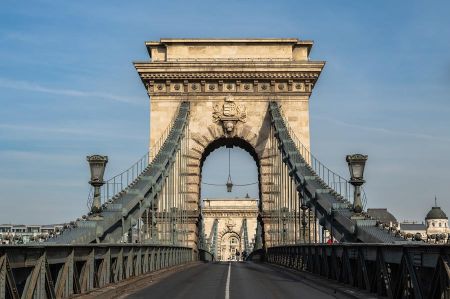 Whether for work, for a day trip, or simply to take a photo – the bridge is as vibrant as ever.
Whether for work, for a day trip, or simply to take a photo – the bridge is as vibrant as ever.
Restorations and Modern Use
It has been repeatedly repaired – most recently, extensively modernized starting in 2021. Yet it remains true to itself: both historical and functional.
A Walk Across the Lánchíd Bridge
Daytime and Nighttime Atmosphere Compared
By day, you can see the expanse of the Danube; by night, the bridge glows romantically in the light of the lanterns – an experience for all the senses.
The perfect spot for vacation photos
With views of the Parliament, the Fisherman's Bastion, or Gellért Hill, the bridge offers plenty of photo opportunities.
The surrounding area – Sights around the bridge
Clark Ádám Square and the funicular to the castle
At the Buda end of the bridge is the pretty Clark Ádám Square – from here, the historic funicular starts up to Buda Castle.
Chain Bridge District and Danube Promenade
In Pest, the Danube promenade invites you to stroll – with views of boats, restaurants, and the famous Parliament.
Events and Light Shows
Holidays and Illuminations
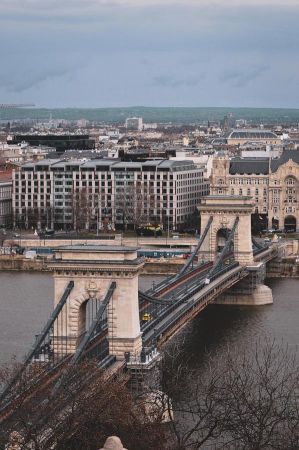 For the founding of the country on August 20th or on New Year's Eve – the Lánchíd shines in bright colors and becomes a stage for fireworks and light shows.
For the founding of the country on August 20th or on New Year's Eve – the Lánchíd shines in bright colors and becomes a stage for fireworks and light shows.
The bridge as a stage for culture and festivals
Concerts, exhibitions, and performances regularly take place nearby – it is and remains a part of urban life.
The significance for locals and visitors
Emotional connection to history
For many Hungarians, it's not just a building, but part of their identity – it's part of everyday life, a place of memory, a place of pride.
A profound tourist attraction
Visitors come for the view – and stay for the stories. Because this bridge has a lot to tell.
Tips for your visit
Best times for photos and walks
Early in the morning or at sunset, the atmosphere is particularly beautiful – fewer people, more magic.
Viewpoints with a wow factor
Be sure to look at the bridge from Castle Hill – an unforgettable panoramic view.
The Chain Bridge as a metaphor
A bridge between past and future
 It stands for change, for connection, for overcoming differences – exactly what defines Budapest.
It stands for change, for connection, for overcoming differences – exactly what defines Budapest.
Connecting cultures, ideas, and people
Whether tourist or local – on this bridge, you meet at eye level. That's precisely where its magic lies.
Conclusion – A Bridge That Connects Hearts
The Széchenyi Chain Bridge is more than a piece of steel and stone – it is emotion, identity, and experience all in one. Anyone visiting Budapest cannot miss it – and they don't even want to.
FAQs about the Széchenyi Chain Bridge in Budapest
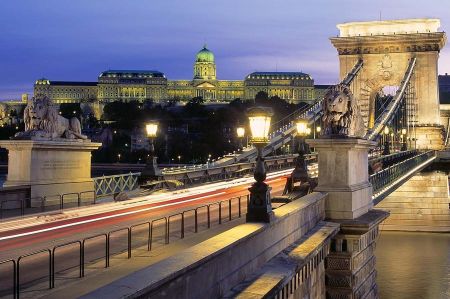 1. Is the bridge accessible to pedestrians?
1. Is the bridge accessible to pedestrians?
Yes, it is open to both pedestrians and cars (depending on the state of repair).
2. When was the bridge built?
The original bridge opened in 1849, and the reconstruction took place in 1949.
3. Is there an entrance fee?
No, it is free.
4. Is the bridge illuminated at night?
Yes, it is especially beautifully illuminated in the evening.
5. What does the name "Széchenyi" mean?
The bridge is named after István Széchenyi – an important Hungarian reformer.
Coordinates: 47°29'55.9"N 19°02'35.7"E -- 47.498855, 19.043252
Please read as well:
Monument against facism - shoes on the bank of Danube
Walk across the Margareten Island of Budapest
-
 Budapest famous Chain Bridge at Danube
Budapest famous Chain Bridge at Danube
Budapest famous Chain Bridge at Danube
Budapest famous Chain Bridge at Danube
-
 Budapest famous Chain Bridge at Danube
Budapest famous Chain Bridge at Danube
Budapest famous Chain Bridge at Danube
Budapest famous Chain Bridge at Danube
-
 Budapest famous Chain Bridge at Danube
Budapest famous Chain Bridge at Danube
Budapest famous Chain Bridge at Danube
Budapest famous Chain Bridge at Danube
-
 Budapest famous Chain Bridge at Danube
Budapest famous Chain Bridge at Danube
Budapest famous Chain Bridge at Danube
Budapest famous Chain Bridge at Danube
-
 Budapest famous Chain Bridge at Danube
Budapest famous Chain Bridge at Danube
Budapest famous Chain Bridge at Danube
Budapest famous Chain Bridge at Danube
-
 Budapest famous Chain Bridge at Danube
Budapest famous Chain Bridge at Danube
Budapest famous Chain Bridge at Danube
Budapest famous Chain Bridge at Danube
-
 Budapest famous Chain Bridge at Danube
Budapest famous Chain Bridge at Danube
Budapest famous Chain Bridge at Danube
Budapest famous Chain Bridge at Danube
-
 Budapest famous Chain Bridge at Danube
Budapest famous Chain Bridge at Danube
Budapest famous Chain Bridge at Danube
Budapest famous Chain Bridge at Danube
-
 Budapest famous Chain Bridge at Danube
Budapest famous Chain Bridge at Danube
Budapest famous Chain Bridge at Danube
Budapest famous Chain Bridge at Danube
-
 Budapest famous Chain Bridge at Danube
Budapest famous Chain Bridge at Danube
Budapest famous Chain Bridge at Danube
Budapest famous Chain Bridge at Danube
-
 Budapest famous Chain Bridge at Danube
Budapest famous Chain Bridge at Danube
Budapest famous Chain Bridge at Danube
Budapest famous Chain Bridge at Danube
-
 Budapest famous Chain Bridge at Danube
Budapest famous Chain Bridge at Danube
Budapest famous Chain Bridge at Danube
Budapest famous Chain Bridge at Danube
-
 Budapest famous Chain Bridge at Danube
Budapest famous Chain Bridge at Danube
Budapest famous Chain Bridge at Danube
Budapest famous Chain Bridge at Danube
-
 Budapest famous Chain Bridge at Danube
Budapest famous Chain Bridge at Danube
Budapest famous Chain Bridge at Danube
Budapest famous Chain Bridge at Danube
-
 Budapest famous Chain Bridge at Danube
Budapest famous Chain Bridge at Danube
Budapest famous Chain Bridge at Danube
Budapest famous Chain Bridge at Danube
-
 Budapest famous Chain Bridge at Danube
Budapest famous Chain Bridge at Danube
Budapest famous Chain Bridge at Danube
Budapest famous Chain Bridge at Danube
-
 Budapest famous Chain Bridge at Danube
Budapest famous Chain Bridge at Danube
Budapest famous Chain Bridge at Danube
Budapest famous Chain Bridge at Danube
-
 Budapest famous Chain Bridge at Danube
Budapest famous Chain Bridge at Danube
Budapest famous Chain Bridge at Danube
Budapest famous Chain Bridge at Danube
https://www.alaturka.info/en/hungary/budapest/4025-szechenyi-lanchid-chain-bridge-across-danube-in-budapest#sigProIdda640a0a64
